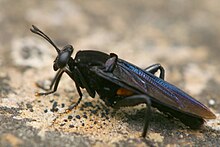Mydas clavatus
| Clubbed mydas fly | |
|---|---|

| |
| Scientific classification | |
| Domain: | Eukaryota |
| Kingdom: | Animalia |
| Phylum: | Arthropoda |
| Class: | Insecta |
| Order: | Diptera |
| Family: | Mydidae |
| Subfamily: | Mydinae |
| Tribe: | Mydini |
| Genus: | Mydas |
| Species: | M. clavatus
|
| Binomial name | |
| Mydas clavatus | |
| Synonyms | |
Mydas clavatus, the clubbed mydas fly, is a species of Mydas fly that is native to temperate, eastern North America. It is named for its clubbed antennae, which is however a general feature of the Mydas flies. An orange to red mark on the abdomen is distinctive. It is a Batesian mimic of certain spider wasps, and is consequently quite bold in its movements.[4][5][6] Adults fly in mid-summer.
Description
[edit]
They are large, black and somewhat glabrate flies that measure some 25 to 30 mm in length, with a wingspan that may exceed 50 mm.[4] A prominent orange to red mark is evident on the ventral side of the second abdominal segment. Their visual mimicry is apparently complemented by curling and jabbing of the abdomen in a mock stinging routine.[7]
Biology
[edit]The eggs are deposited singly in soil or rotting wood.[4] The larvae, as with M. brunneus and M. tibialis, are predatory on the larvae of deadwood-feeding scarab beetles (Osmoderma species.) and can be found in standing and downed trees with extensive heart rot. The adults seem to be pollen and nectar feeders only, and have been observed at Asclepias, Saponana, Spiraea, Monarda, Pycnanthemum, Teucrium and Verbena flowers.[7] When not nectaring, adults may be seen resting on plants or actively running around on the ground.[8] Though the mating behaviour is unknown, it is suspected that males may defend the vicinity of larval food sources.[4]
Habitat
[edit]They are present in various habitats, including deciduous woodlands, fields, meadows, gardens, and other.[4]
References
[edit]- ^ a b Drury, D. (1770–1773). Illustrations of natural history... Vol. 1. London: Printed for the author; sold by White. pp. xxviii + 130 pp., 4 figs., 50 pls.
- ^ Fabricius, J.C. (1775). Systema entomologiae, sistens insectorum classes, ordines, genera, species, adiectis synonymis, locis, descriptionibus, observationibus. Flensbvrgi et Lipsiae [= Flensburg & Leipzig]: Kortii. pp. [32] + 832. Retrieved 20 February 2021.
- ^ De Geer, C. (1776). Memoires pour servir a l'histoire des insectes. Stockholm: P. Hesselberg. pp. viii + 523 pp., 30 pls.
- ^ a b c d e Cotinis; Moisset, Beatriz; McLeod, Robin (24 July 2015). "Species Mydas clavatus". BugGuide. Retrieved 12 February 2018.
- ^ Wilcox, J.; Papavero, N.; Pimentel, T. (1989). Studies of Mydidae (Diptera). IVb. Mydas and allies in the Americas (Mydinae, Mydini). Belém: Museu Paraense Emilio Goeldi. pp. 139 pp.
- ^ Artigas, Jorge N.; Papavero, Nelson (1990). "Studies on Mydidae Diptera v. Phylogenetic and biogeographic notes key to the American genera and illustrations of spermathecae". Gayana Zoología. 54: 87--116. Retrieved 2 June 2023.
- ^ a b Raupp, Michael J. (6 July 2015). "A fly with a golden touch? Mydas fly, Mydas clavatus". Bug of the week. Retrieved 12 February 2018.
- ^ Padelford, Loren (2008). "Nature Search: Mydas clavatus". Fontenelle Forest. Retrieved 12 February 2018.
 Media related to Mydas clavatus at Wikimedia Commons
Media related to Mydas clavatus at Wikimedia Commons
